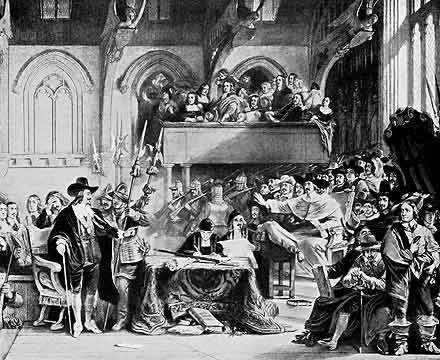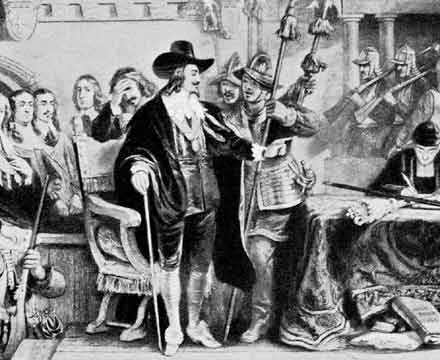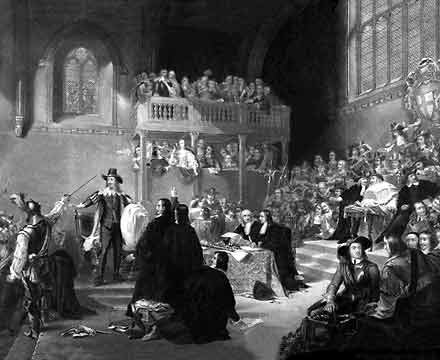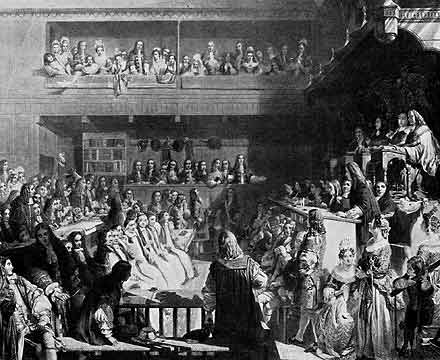Westminster Hall - Famous State Trials
© 2007
Armchair Travel Co. Ltd. - This page may be used for non-commercial purposes
ONLY!
![]()

[ Play
Narrated and Animated Movie ! ] Westminster Hall traditionally contained the highest Courts of Law in the land. As a result there have been some very famous and memorable State Trials which have taken place inside the walls of this ancient building. When State Trials took place the litter of the courts was swept away and great terraces of scaffolding were built all around for the spectators to occupy.
In 1535 Sir Thomas More stood in Westminster Hall to hear his sentence announced, after falling prey to the unjust tribunal and the disfavour of Henry VIII.
During the turbulent Tudor period of history, a number of famous Dukes and nobles, were condemned to death in the Hall.
The Seventeenth century also saw many famous trials, one of the more notable being the conspirators of the Gunpowder Plot who were tried here in January 1606. The sentence on Guy Fawkes was afterwards carried out with terrible thoroughness, as numerous etchings of the torture have vividly depicted . In 1640 took place the trial of Thomas Wentworth, Earl of Strafford, in the presence of King Charles, Queen Henrietta Maria, both Houses of Parliament and a large number of the public.
However, it was 1649 saw the most famous trial in British History - that of King Charles I. Throughout his trial the King, dressed in a black cloak with the great radiating silver star of the Garter, conducted himself with dignity, never wavering in his belief that he ruled by divine right, and tenaciously challenged the right of the tribunal to sit in judgement over him
Remember I am your king, your lawful king, - think well upon it before you go further from one sin to a greater.
For three days Charles sat impassive, refusing to answer the charges brought against him, denying calmly and sternly the authority of the court
On the final day the Lord President of the High Court of Justice was summing up;
Gentlemen, the Prisoner at the Bar hath been several times brought before the court to make answer to a charge of High Treason in the name of the people of England...
Lady Fairfax interrupted him;
Not half nor a quarter of the people of England
Upon which Colonel Axtell ordered his men to level their muskets and cried;
Down with the whore!
The triumphant Parliamentary party acting as the King's judges found the King guilty of treason, and he was sentenced to death by execution on the 30th January 1649.
Charles Stuart - Tyrant, Traytor, Murtherer and publicke Enemy shall be put to death, by the severing his head from his Body.
In June 1688 the seven bishops of the Anglican Church were brought to trial for declining to accept James II's Act of Indulgence. The public support for the bishops' cause was immense and crowds of supporters poured their blessings upon the bishops as they were led from the Tower to the hall. The bishops were triumphantly acquitted.
The eighteenth century saw many trials arising as a result of political conflict, the impeachment of Warren Hastings probably being the most important example. The trial which began in February 1788 lasted for seven years. The galleries were crowded with spectators, and even the Royal Family made their appearance, as did various ambassadors, and even the painter Reynolds. Politicians involved included Fox, Sheridan, Windham and Grey. Public interest grew throughout, until on the 23rd of April 1795 an acquittal was pronounced by 23 peers against 6.
The last state trial held in the Hall was the impeachment of Henry Dundas, Viscount Melville, in 1806, on charges of misuse of public funds.
[ Virtual
Tour ] [ Main Topics
Index ]
- Charles.
- Lord President of the High Court of Justice.
- Lady Fairfax.
- Colonel Axtell.
- The Judges.




















Explore-Parliament.net: Advanced Category Search
Keyword Categories:
_Event_Historical
_Setting_Westminster
_Setting_England
_Trials